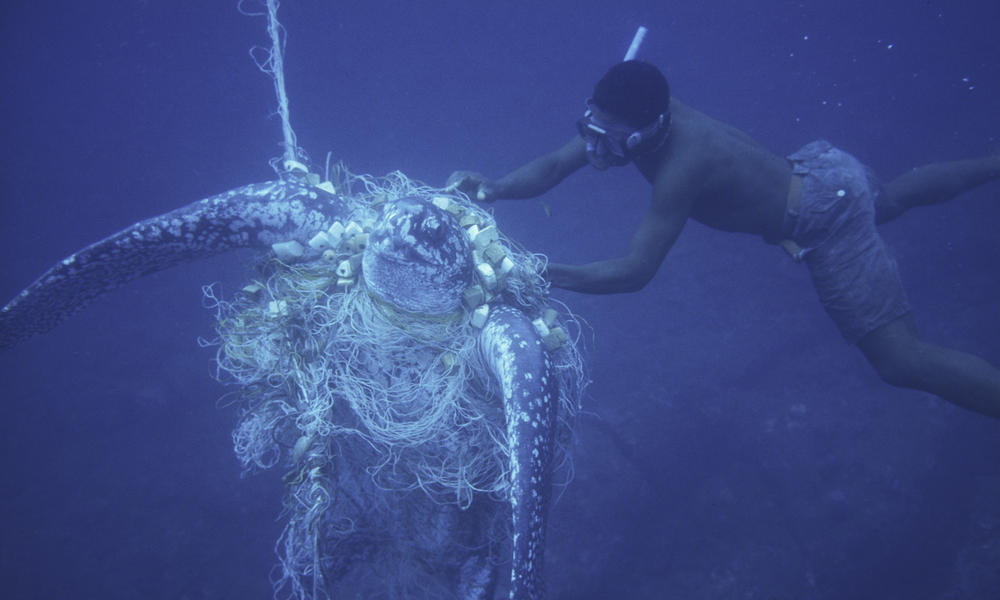
http://assets.worldwildlife.org/photos/889/images/story_full_width/bycatch-impactsHI_111696.jpg?1345581040
By Shivani Kuckreja
Imagine a world in which your children can watch from afar as leatherback turtles wade out of the water and rest themselves on the warm sands that your children share with creatures that date back to 100 million years ago. Imagine the opportunity to witness a female leatherback turtle lay eggs and return to the water while you watch for any signs of life under thin white shells. Imagine swimming overhead these beautiful creatures in the vast expanse of the eerily calm ocean.
Unfortunately, this imaginary world stands in sharp contrast to what we see today. Today, the endangered leatherback turtle population is at risk of going extinct. These turtles are being found washed ashore in fishing nets, their necks covered with fish hook incisions. Their shells remain wrapped in plastic litter for so long that they often become deformed. Furthermore, in Chile, Peru, and Mexico, leatherback turtles are seen as pests to be exterminated. The most pressing problem that leatherback turtles face, however, is their lack of solitary nesting space.
Oftentimes, the eggs of leatherback turtles are smuggled in bulk to serve as sources of food, particularly in Malaysia. Furthermore, heavy machinery and fast-moving vehicles on beaches can crush leatherback turtle eggs, leaving fewer hatchlings to contribute to overall population growth. The graph below illustrates the decrease in leatherback turtle nesting in Malaysia’s Terengganu State.

http://seatru.umt.edu.my/wp-content/uploads/sites/40/2014/06/The-Leatherback-Turtle-Population-in-Terengganu.gif
Leatherback turtles are as important as they are majestic. The species works wonders for our ecosystems and helps our economy thrive. Fewer leatherback turtles in our waters will have serious repercussions. The turtles’ main source of nutrition is jellyfish, and leatherback turtles prey on jellyfish most often compared to other turtles. In a single day, a leatherback turtle can consume up to 440 pounds worth of jellyfish. Thus, the loss of the leatherback turtle population would cause a burgeoning of the jellyfish population. Because jellyfish feed on fish larvae, the populations of commercially popular fish could decline, impacting fishermen and consumers, thus impacting our economy.
What comes as the largest surprise is that saving earth’s last dinosaur may not be that expensive. On a quest to understand “the most cost-effective means of achieving increases in leatherback populations” (Gjertsen, et al., 2014), researchers looked at three different leatherback turtle conservation strategies: Papua, Indonesia’s nesting beach protection (beginning in the early 2000s), the Hawaiian longline’s turtle take governance in swordfish fisheries, and California’s time and area-related closures within the drift gill net fishery.
Building off of previous studies in Indonesia, Hawaii, and California, researchers Gjertsen, Squires, Dutton, and Eguchi found that the most cost-effective means of growing the leatherback turtle population is by establishing nesting beach protection. While Indonesia’s nesting beach efforts cost an estimated $209, 261 annually and save an estimated 134 adult female leatherback turtles per year, the other two efforts cost more and yield smaller benefits. The estimated annual cost of Hawaii’s longline turtle take regulations is $2,805,426 while benefits fall short at the estimated saving of 100 adult female leatherbacks. Similarly, the closures in California cost an annual fee of about $2,053,964 but is estimated to be saving only 10 adult female leatherbacks annually. The study concludes that if we want to save the turtle population, we should look to invest time, effort, and money into encouraging and improving nesting site conservation.
Conservation can begin at your local beach. It can be as simple as asking the lifeguard to enforce rules that keep people away from resting turtles on the beach. Perhaps beaches with frequenting turtles can have informational guides that raise awareness about the beautiful and valuable leatherback turtle and about its current status of endangerment.
Conservation efforts can also take place at the government and policy level. Governments can section off 20% of every beach solely for leatherback turtle and other sea creature nesting. In such a situation, monitoring and enforcement will help nesting site conservation be as effective as possible. If someone enters the conservation section of beach, they do so at the risk of being fined $100.
The World Wildlife Fund has already taken steps in the right direction to help ensure that leatherback turtle populations grow and thrive in the coming years. By establishing marine protected areas, these turtles are free to nest and migrate at ease.
While these serve as just a few example of the many ways in which nesting site conservation can pan out, changing social norms and re-evaluating our values will be at the forefront of the discussion on saving the leatherback turtle. How long can we humans maintain our superiority over other creatures? When will we fully understand that we rely on everyone and everything in our environment? What will it take for us to learn that we should work to coexist with other creatures?